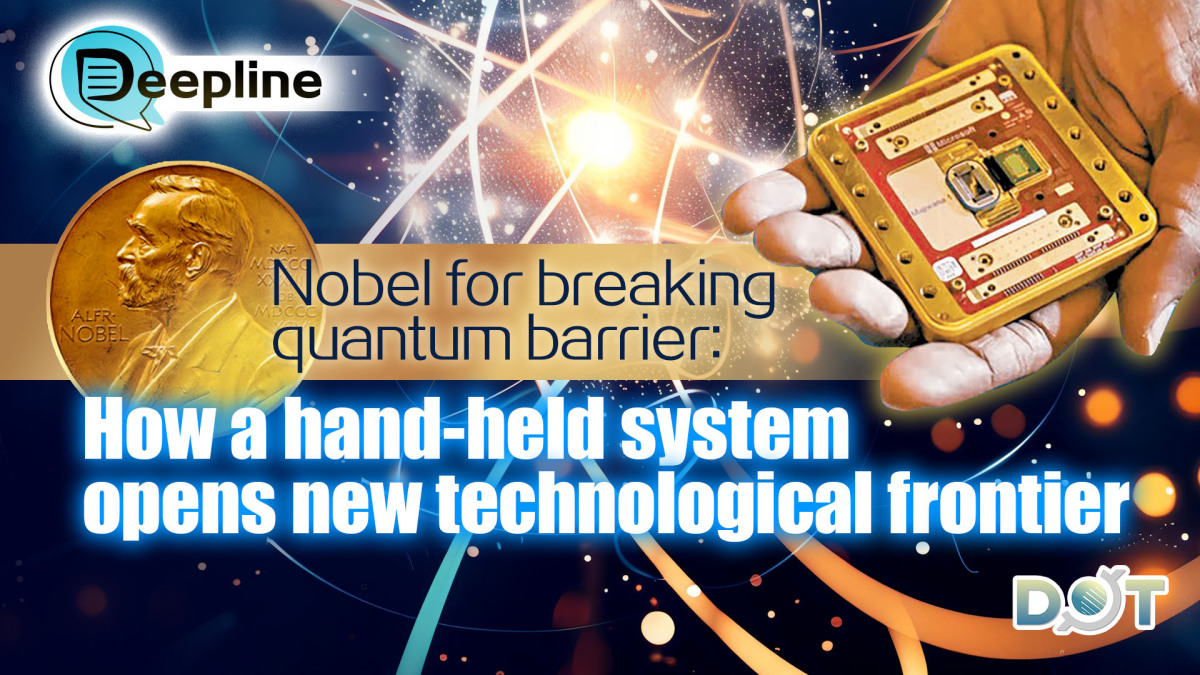
In the world of physics, the profound realm of quantum mechanics serves as the foundation for quantum technologies such as computing, encryption, and sensing. The maximum scale at which systems can demonstrate quantum effects has always been a focal point in the field of physics.
On Tuesday (Oct. 7), the Royal Swedish Academy of Sciences announced that this year's Nobel Prize in Physics has been awarded to three scientists—John Clarke, Michael H. Devoret, and John M. Martinis—in recognition of their discovery of macroscopic quantum tunneling effects and energy quantization in a system small enough to be held in hand. Their work confirmed that quantum effects can manifest in macroscopic systems, paving the way for numerous quantum technologies that are transforming the human world.
Quantum mechanics typically describes physical laws at the scale of individual particles, phenomena referred to as "microscopic." In contrast, "macroscopic" objects composed of a large number of particles do not exhibit observable quantum behaviors. For example, when a basketball is thrown against a wall, it bounces back; when a coin is tossed and lands in the palm, it shows either heads or tails. However, in the microscopic world, a single particle can "pass through a wall" or simultaneously land as both heads and tails. This phenomenon, where particles seemingly traverse insurmountable energy barriers, is known as the quantum tunneling effect.
In the world of microscopic particles, quantum tunneling appears random and enigmatic. Through statistical analysis of large samples, scientists can estimate their half-life. However, when a system contains a large number of particles, these quantum effects rapidly diminish. Whether a multi-particle system can simultaneously exhibit tunneling behavior and precisely demonstrate quantum characteristics on a macroscopic scale has long been a challenging research problem in physics.
Exhibiting quantum characteristics in superconductors
Between 1984 and 1985, within a physics research group at the University of California, Berkeley, the advisor Clarke, postdoctoral researcher Devoret, and doctoral student Martinis collaboratively designed an experiment to demonstrate quantum characteristics on a macroscopic scale. To ensure the system was isolated from external interference, they used superconducting materials to construct a special circuit, separated by an extremely thin insulating layer to form a "Josephson junction" (a conductive structure in a resistance-free state), and measured changes in current and voltage with extremely high precision.
In their experiment, the three scientists precisely controlled the circuit parameters and observed that when an electric current passed through, countless densely packed charges in the entire superconducting system behaved as if they were a single "macroscopic particle" filling the circuit. This system, resembling a macroscopic particle, initially existed in a "zero-voltage" state, seemingly trapped behind an insurmountable energy barrier. However, subsequent experiments revealed that this system could also transition out of the zero-voltage state through the quantum tunneling effect, thereby demonstrating its quantum characteristics.
Through their experiments, the three scientists meticulously recorded the time required for the macroscopic particle system to transition via quantum tunneling and statistically depicted its distribution curve. Further research showed that when microwaves of different wavelengths were applied, the system absorbed energy at specific frequencies and transitioned to higher energy levels. This behavior aligned with the predictions of quantum mechanics and was entirely consistent with the energy absorption and transition patterns of microscopic particles.
From microscopic to macroscopic: Laying experimental foundation for quantum computing and beyond
This groundbreaking research opened the door to a diverse and transformative world of quantum technologies. Unlike previous studies where macroscopic outcomes (such as lasers, superconductors, or superfluids) emerged from microscopic phenomena, this research directly demonstrated quantum behavior within a macroscopic system. Researchers regard this macroscopic quantum state as a type of artificial atom, using it to explore the laws of the microscopic world and to establish the experimental foundations for quantum computing and quantum sensing.
The Chair of the Nobel Committee for Physics, Olle Eriksson, stated that the award-winning technology is key to the new generation of quantum technologies. "It is wonderful to be able to celebrate the way that century-old quantum mechanics continually offers new surprises," he noted. "It is also enormously useful, as quantum mechanics is the foundation of all digital technology.
The three scientists will equally share the prize money of 11 million Swedish kronor (approximately HK$9.12 million).
CityU professor: Quantum mechanics drives AI applications
Prof. Io-Chun Hoi, Associate Professor in the Department of Physics at City University of Hong Kong, explained that the award-winning experiment in 1985 employed an extremely innovative method to observe quantum tunneling phenomena on a macroscopic scale. The experiment by the three physicists demonstrated that the remarkable quantum characteristics—like a ball passing through a wall without bouncing back—could indeed be precisely exhibited on a macroscopic level.
Prof. Hoi also said that the macroscopic system in the experiment exhibited characteristics of "energy quantization." In energy transfer within the microscopic world, when particles absorb or release energy, they "jump" from one energy level to another—a process termed "quantum leap." The award-winning experiment discovered that macroscopic systems can also absorb energy at specific frequencies and transition to higher energy levels, with behavior consistent with the transition patterns of individual particles.
One of this year's Nobel laureates in physics, Martinis, during his tenure at the tech company Google, participated in the development of the quantum processor "Sycamore." When performing specific tasks, its computational speed far surpassed that of classical supercomputers.
Prof. Hoi noted that large tech companies are now actively investing in the research and development of quantum computers, exploring how they can assist in the application of AI technology. If the computational power of AI can be elevated with the help of quantum computers, advanced AI technologies are expected to be applied in processing complex data, performing various tasks, and, in the long term, supporting the expansion of AI technologies into more fields.
Prof. Hoi, who worked with Martinis for a year and a half, recalled that Martinis is an enthusiastic person. During every academic discussion, Martinis actively participated, offered encouragement, and shared his unique insights. Prof. Hoi greatly admired Martinis's positive attitude toward academic research and benefited significantly from it.
Editor's note | Quantum mechanics: Ubiquitous and unavoidable
By Darius
For many, quantum mechanics is an intimidating "buzzword" that sounds impressively complex. In reality, however, it has long permeated our daily lives. On a grand scale, quantum mechanics has fundamentally transformed our understanding of the world, breaking the constraints of classical mechanics and successfully explaining numerous phenomena that were previously incomprehensible within the classical framework. On a more practical level, every modern electronic device we use—equipped with a chip—relies on core components like semiconductors and transistors, whose operational principles are deeply rooted in quantum mechanics.
Typically, quantum mechanics is perceived as a field born from microscopic studies and later extended to macroscopic applications, which naturally shrouds the discipline in an aura of mystery. Now, three scientists have successfully conducted quantum research within a macroscopic system.
It seems that the ability to break through barriers lies not only with quantum particles themselves but also with the scientists who study them.
(Source: Wen Wei Po; English Editor: Darius)
Related News:
Deepline | Through astronauts' lenses: Story behind China's first movie filmed in space
Deepline | China's DeepSeek-R1 AI model pioneers peer-reviewed transparency in Nature




















Comment